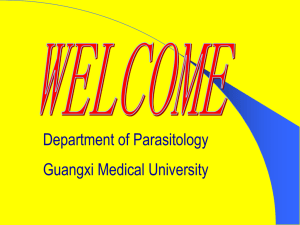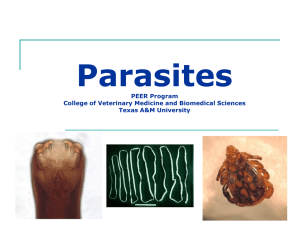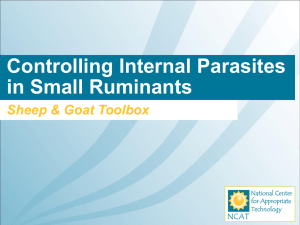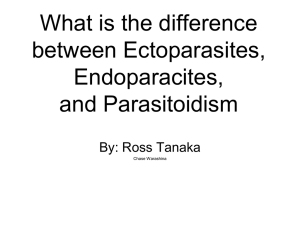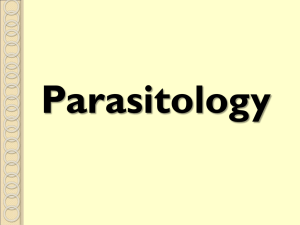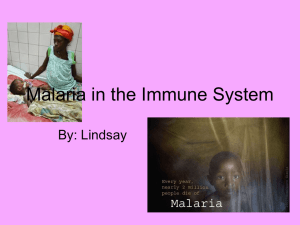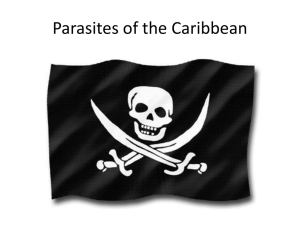عرض تقديمي من PowerPoint
advertisement
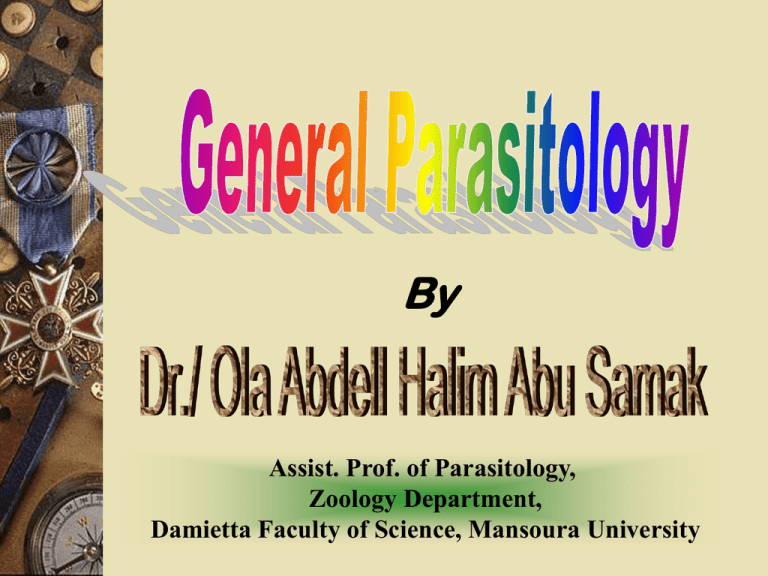
By Assist. Prof. of Parasitology, Zoology Department, Damietta Faculty of Science, Mansoura University Topics NO. of hours Date 1 Parasitology and Parasitism 1 22 Sept. 2 Protozoan Parasites 1 29 Sept. 3 Protozoan Parasites 1 6 Oct. 4 Protozoan Parasites 1 13 Oct. 5 Protozoan Parasites 1 20 Oct. 6 Worm Parasites 1 27 Oct. 7 Worm Parasites 1 3 Nov. 8 Revision 1 10 Nov. 9 Worm Parasites 1 17 Nov. 10 Worm Parasites 1 24 Nov. 11 Worm Parasites 1 1 Dec. 12 Worm Parasites 1 8 Dec. 13 Worm Parasites 1 15 Dec. 14 Revision 1 22 Dec. 15 Final Exam 1 *Dr. Ola Abdell Halim Abu Samak *Office hours: *Phone: 0572403981-168 *Email: olasamak@mans.edu.eg *Lecture: 1 hour *Labs: 2 hours Parasites and Parasitism Lecture 1 Aim of the lecture Increasing the familiarity with the parasites and host relations Recognizing the parasitism among the other biological relationships Comparing between different biological relationships and monitoring in the surrounding environment Identifying the biological relationships Do Parasites Rule the World? Parasites are often occupying the 3rd great environment (aquatic-terrestrial-parasitic) *Traditionally, only considered to be protists, worms, and arthropods. *Now known to encompass everything from prokaryotes up to the diversity of metazoans. *One of the most common lifestyles in existence, with an estimate 1/3 of life being parasitic (Price 1980). *In fact, of the 35 animal phyla, only echinoderms, chordates, and a few minor phyla do not have representative parasitic members. Organismal Associations Any association more or less permanent is called a symbiosis, with each member a symbiont. Symbiosis is used as a n umbrella term for organisms that live together Symbiosis Phoresis Commensalism Mutualism Parasitism Phoresis Two organisms simply travel together Neither organism is helped or harmed Usually one is transporting the other Examples of Phoresis Barnacles on a whale Burrs attached to fur of mammals Or your socks and shoe laces Dematobia (bot fly) eggs on mosquito Female bot fly lays eggs on female mosquito Eggs drop off when mosquito feeds Fungal spores on legs of house fly Commensalism One benefits but the other isn’t harmed and receives no benefits Usually one feeds off the “wastes” of the other partner. Commensalism Examples Remoras and sharks *Feed on scraps left by shark Humans have many commensals *Intestinal protozoans and bacteri *Entamoeba Gingivalis Amoeba in the mouth *Eyelash mites Mutualism Both organisms benefit from the relationship Usually obligatory Both partners realy on the relationship and can’t live without the other. Mutualism Examples Coral and Zooxanthelle Termites and bacteria Bacteria digest wood Cleaner fish and the fish they clean Leeches and bacteria Bacteria digest blood Humans and bacteria Bacteria make vitamins out of our wastes Parasitism One organism benefits while the other organism is harmed The amount of harm can vary -Mosquito bite causes minor irritation -Some parasites steal nutrients -Some cause major damage that can result in death of other organism Parasite is in wrong host Parasites in large numbers Symbiosis The line between some the categories may be difficult to draw. A parasite in one organism may be a commensal in another organism. How much “harm” is necessary before a commensal becomes a parasite? Predation Predation is frequently viewed as a symbiosis Interaction between two organisms One organism dies at the end of the interaction. The interaction occurs over a very short time Predation vs. Parasitism Predation and parasitism may seem to be the same. One organism benefits, other is harmed Both can result in an evolutionary arms race The host/prey gets better at avoiding the parasite/predator so the parasite/predator must adapt But there are significant differences. Predation results in the death of one of the organism. Parasites usually try to keep host alive. Predator is larger than the prey. Parasites are usually smaller than host. Predator preys on many individuals in a lifetime. Parasite usually spends entire life in one or two host Parasitology Usually restricted to protozoans and multi-cellular animals that are parasitic on other animals, particularly humans. Does not include bacteria and viruses parasites on plants Our Focus in Parasitology Learn the taxonomic groups of parasites Recognize life cycles for important parasites Identify diseases associated with particular parasites, and how to recognize them Parasites or not? If an animal lives inside another, but is not actively causing harm, is it a parasite? If an animal temporarily feeds upon another, but leaves its prey alive, is it a parasite? If an animal lays its eggs in another, and the young consume the host from the inside-out, is it a parasite? A simple view In a straight forward situation a small organism (Parasite) has the potential to harm a larger organism (Host), and relies on said host for nutrients and shelter (a Niche). The parasite generally has a much higher reproductive capability compared to its host. Unfortunately, parasitism is seldom this clear cut. Types of Parasites Endoparasite vs Ectoparasite Living inside or outside the host What about Pneumonyssus simicola that infest nasal passages and lungs? Temporary vs Permanent Only on host to feed or only off the host to disperse Obligate vs Facultative Must have the host to complete life cycle or freeliving organism capable of infesting a host under the right conditions. Types of Parasites 1- Location Endoparasite Lives inside the body of the host may be just under the surface or deep in the body Tapeworms, flukes, protozoans Ectoparasite Stays on outside surface of the host Mosquitoes, leeches, ticks, fleas, brood parasites Types of Parasites 2 – Required or not Obligate Parasite Requires finding and invading the host to complete its life cycle Most of the parasites we will cover are obligate parasites Facultative Parasite May become parasitic if it is given the chance but does not require a host. Types of Parasites 3- Amount of time spent Permanent Parasite Lives entire adult life stage on or in a host Usually endoparasites One exception is eyelash mite Temporary Parasite Spends only a short time on a host Usually ectoparasites Types of Hosts Definitive Host Host where sexual reproduction (or any other gene shuffling) takes place. In the few parasites with only asexual reproduction, it is the host most important to humans. Intermediate Host Required in the life cycle of parasite. No reproduction or asexual reproduction takes place. Types of Hosts Paratenic or Transport Host No development occurs but parasite remains alive May go dormant May cause damage Accidental or Incidental Host Parasite is in the “wrong” species. Parasite usually wanders around and causes great damage because it doesn’t know where to go then dies. Types of Hosts Reservoir Host Any animal that carries a parasite that can cause infections in humans. Even if it is the normal host for that parasite. Related to the medical perspective of parasitology Vector Any organism that transmits infections to humans. Broader because it includes organisms that carry parasites, bacteria, and viruses. Frequently, it is an obligate host for a parasite. Life Cycles Direct life cycle Transmitted from one host to another through the air, by a fomite, or in contaminated food or water. Indirect life cycles requires a vector or intermediate host to reproduce or grow in. Tritrichomonas foetus Direct life cycle Indirect life cycle How are Parasites Studied? Need to be familiar with invertebrate and vertebrate zoology Taxonomy and systematics Histology and cytology Immunology Molecular biology Vector Biology and the study of life cycles Our Focus in Parasitology Learn the taxonomic groups of parasites Recognize life cycles for important parasites Identify diseases associated with particular parasites, and how to recognize them
